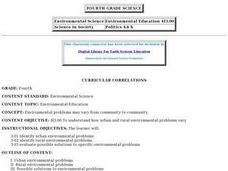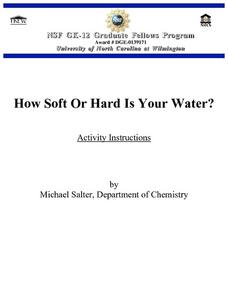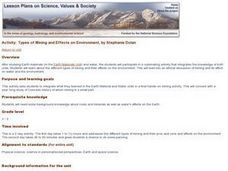Curated OER
Electroplating for Corrosion Protection: Redox in Action
Learners define what a redox reaction is. In this chemistry activity, students electroplate some wires in the lab. They research the application of electroplating in the real world.
Curated OER
Melting and Freezing of Water
Students differentiate the three states of matter. In this chemistry lesson plan, students analyze graphs of heating and cooling curve of water. They complete a lab report and discuss results.
Curated OER
What's Hiding in the Air?
Fifth graders conduct experiments to study the effects of invisible air pollutants including one with a bean plant. They examine methods of invisible air pollutants.
Curated OER
Different Types of Orange Juice Contain the Same Amounts of Vitamin C?
Students measure and compare the amount of vitamin C in orange juice samples. They discover the effects of different factors on the concentration of vitamin C. They participate in an experiment to test the orange juice.
Curated OER
Polymers
Students explore online tutorial on polymers. In this chemistry lesson, they create two polymers in the lab and compare their properties. They write a sales letter about their new and improved polymer product.
Curated OER
Out of the City and Into the Soup
Students examine the issue of air pollution. They read and analyze an article, evaluate the responses of state and federal officials to the problem, conduct Internet research, and write a letter to their senator and congressman.
Curated OER
Transport
Students analyze wind barbs and determine which way the wind is blowing and how hard the wind is blowing. They access near real time wind data and pollutant animations to track the transport and destination of pollutants.
Curated OER
Virus Tracker
Sixth graders will simulate the spread of a virus such as HIV through a population by "sharing" (but not drinking) the water in a plastic cup with several classmates. Although invisible, the water in a few of the cups will already be...
Curated OER
Code Makers - Electron Configuration, Aufbau Principle
Learners write the electron configuration of elements using the Aufbau principle. In this chemistry lesson, students build their own key that demonstrates the principle.
Curated OER
The Case of the Disappearing Frogs
Students complete an Internet based activity to investigate the case of the disappearing tadpoles. They discover the interrelationship of living things.
Curated OER
Environmental Education -- Communities
Fourth graders identify urban and rural environmental problems. They work together to develop possible solutions. They ask questions to end the lesson.
Curated OER
How Soft or Hard is Your Water?
Students test samples of water to determine how a chemical water softener affects water's ability to form suds. After collecting their data and analyzing their results, students answer follow-up questions about their lab.
Curated OER
Social Studies: Your Family Does What?
Sixth graders compare and contrast their own personal culture with that of Japan. They fill out questionnaires, compile the results, and match them with Japanese answers to the same forms. Students create a Venn diagram of the...
Curated OER
Testing the Waters
Students study the quality of water by running chemical tests on the water. First, they measure pH, temperature, phospates, and nitrates in tap (drinking) water and an outdoor water sample. Then they post and evaluate the results of...
Curated OER
PICKING PEANUTS
Students create sentences, using words printed on pictures of peanuts. They are explained that the peanut is not really a nut, but a legume, related to beans and peas. Students are also told that the first peanuts grew in Brazil. They...
Curated OER
A TOUGH NUT TO CRACK
Based on a set of criteria, students will evaluate the quality of pecans.1. Bring a gram scale and papershell pecans. Provide five pecans for each student. 2. Divide the class into groups of five and provide each member with five pecans....
Curated OER
Water Quality Monitoring
Students comprehend the four parameters of water quality. They perform tests for salinity, dissolved oxygen, pH and clarity or turbidity. Students comprehend why scientists and environmental managers monitor water uality and aquatic...
Curated OER
Using Hazard Symbols
In this hazards worksheet, students determine what the different hazard symbols mean and then match the symbols that would be found on specific chemicals. This worksheet has 1 matching and 3 short answer questions.
Curated OER
A Solution for Moles
Students calculate the concentration of different solutions. For this chemistry lesson, students explain what a solution is. They explain ways to change the concentration of a solution.




















